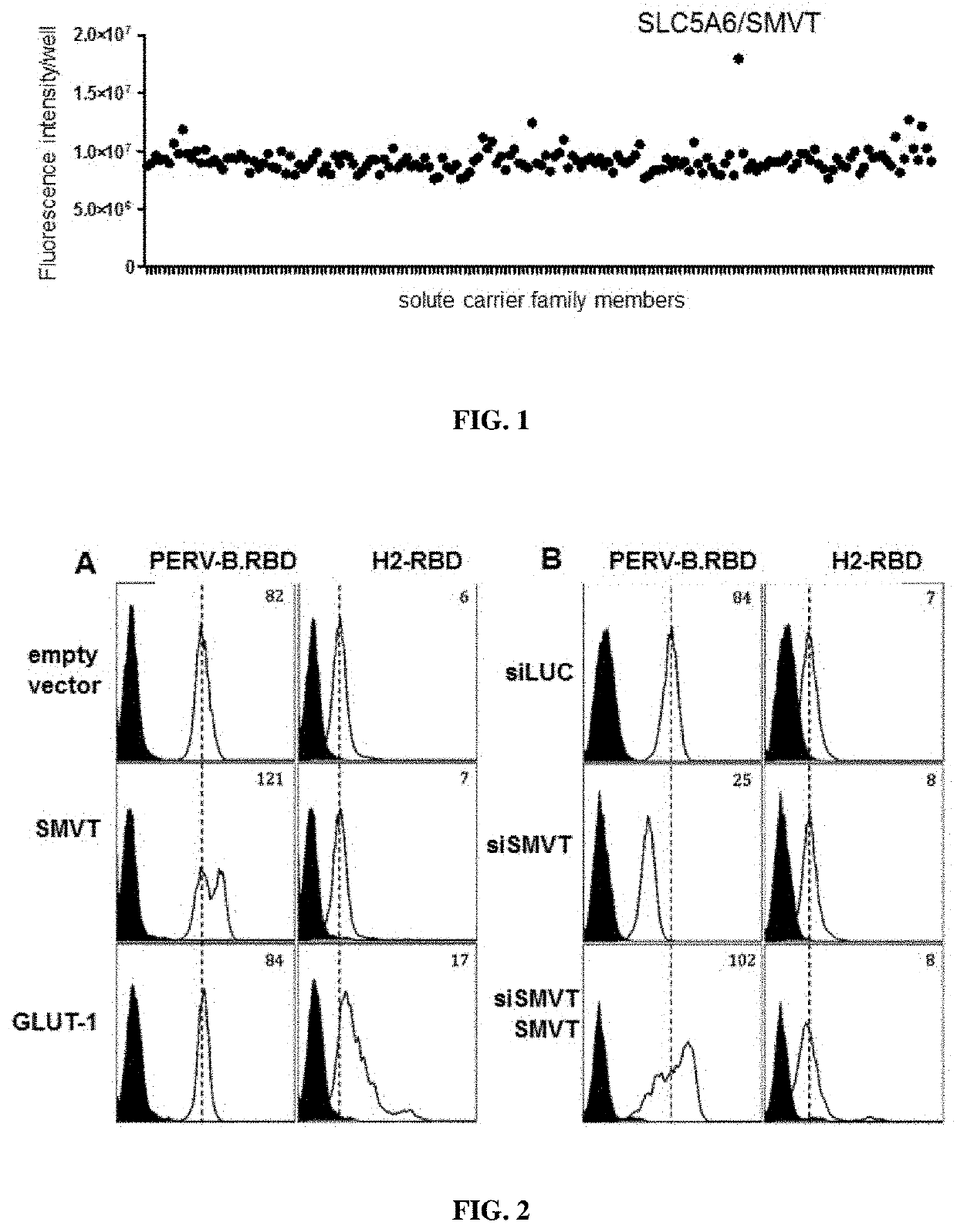Use of ligands derived from receptor-binding domain of porcine endogenous retrovirus type b for diagnosing smvt-related diseases
a technology of porcine endogenous retrovirus and receptor-binding domain, which is applied in the field of disease diagnosis, can solve the problems of limited knowledge of potential targets at the human cell surface recognized by the various rbds, and achieve the effect of reducing the number of rbds
- Summary
- Abstract
- Description
- Claims
- Application Information
AI Technical Summary
Benefits of technology
Problems solved by technology
Method used
Image
Examples
example 1
Automated Screen Identifies SLC5A6 as the PERVB-RBD Cognate Receptor
[0302]Materials and Methods
[0303]Three independent screenings for PERV-B-RBD (SEQ ID NO: 13) binding on a collection of 172 member of the Solute Carrier protein (SLC) family were performed with a Freedom-EVO® robot from Tecan with acquisition of images and fluorescence intensity parameters by Cellomics (Array Scan XTI HCS Thermo Scientific).
[0304]20 000 quail QT6 cells per well were seeded in a 96 well plate coated with poly-D-lysine. 24 hours later, cells were transfected with 100 ng of SLC expression vectors using JetPrime transfection reagent (Polypus Transfection 114-15) according to the manufacturer's instructions. QT6 cell were chosen as the spontaneous binding of the PERV-B.RBD ligand was the lowest among the cell lines considered and tested. Cells were washed the next day with PBS and incubated in fresh DMEM / FBS for 48 hours before binding assays. Binding assays were performed on transfected adherent cells t...
example 2
ty of the Binding of PERV-B.RBD Ligand to SMVT / SLC5A6
[0307]Material and Methods
[0308]5×105 HEK293T cells were seeded on a 6-well plate and transfected with a siRNA directed either against the firefly luciferase gene (siLUC, 5′-CUUACGCUGAGUACUUCGA-3′—SEQ ID NO: 15), or a siRNA directed against the SLC5A6 gene (siSMVT, 5′-GGAUGAGUCUUGGUGUGUUTT-3′—SEQ ID NO: 16). Forty-eight hours post-transfection, cells were detached with 1 mM EDTA in PBS. For the binding assay, 1×105 cells were resuspended in 100 μl of PBA (PBS with 2%1-BS) containing a saturating concentration of either the PERV-B.RBD (SEQ ID NO: 13), or the human T-cell leukemia virus type 2 (HTLV2)-RBD known to bind SLC2A1 / GLUT1, and incubated at 37° C. for 30 min Cells were then washed twice with 100 μl of PBA, incubated with Alexa488-congugated anti-mouse IgG1 at 4° C. for 20 min, washed twice and resuspended in 200 μl of PBA. The results were acquired by flow cytometry on a FACSCalibur (Becton Dickinson) and analyzed by FlowJo...
example 3
ty of the Binding of PERV-B.RBD Ligand to SMVT / SLC5A6, as Assessed with a Second Anti-SMVT siRNA
[0311]Material and Methods
[0312]5×105 HEK293T cells were seeded on a 6-well plate and transfected with a siRNA directed either against the firefly luciferase gene (siLUC, 5′-CUUACGCUGAGUACUUCGA-3′—SEQ ID NO: 15), or a siRNA directed against the SLC5A6 gene and different from the siRNA used in Example 2 (siSMVT A, 5′GCAGGAUCAUGCCAGAAAUTT-3′—SEQ ID NO: 23). Forty-eight hours post-transfection, cells were detached with 1 mM EDTA in PBS. For the binding assay, 1×105 cells were resuspended in 100 μl of PBA (PBS with 2% FBS) containing a predetermined saturating concentration of either the PERV-B.RBD (SEQ ID NO: 13), or a RBD from a xenotropic murine retrovirus (XRBD), whose receptor is known to be XPR1 / SLC53A1, or the HTLV2-RBD (H2), whose receptor is known to be GLUT1 / SLC2A1, or a RBD derived from the bovine leukemia virus (BLV), whose receptor is known to be CAT1 / SLC7A1, or a control superna...
PUM
 Login to View More
Login to View More Abstract
Description
Claims
Application Information
 Login to View More
Login to View More - R&D
- Intellectual Property
- Life Sciences
- Materials
- Tech Scout
- Unparalleled Data Quality
- Higher Quality Content
- 60% Fewer Hallucinations
Browse by: Latest US Patents, China's latest patents, Technical Efficacy Thesaurus, Application Domain, Technology Topic, Popular Technical Reports.
© 2025 PatSnap. All rights reserved.Legal|Privacy policy|Modern Slavery Act Transparency Statement|Sitemap|About US| Contact US: help@patsnap.com


